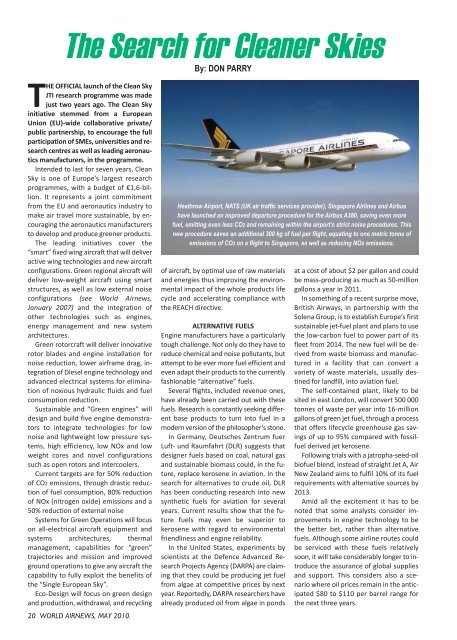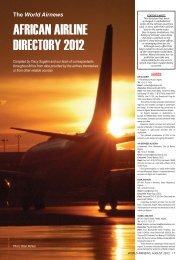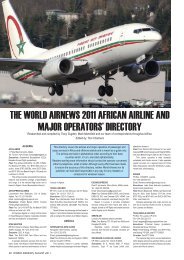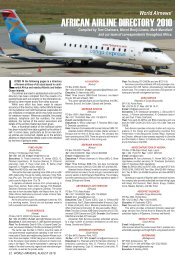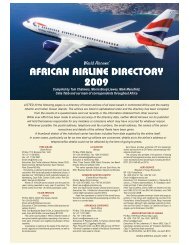May 2010 covers_Covers.qxd - World Airnews
May 2010 covers_Covers.qxd - World Airnews
May 2010 covers_Covers.qxd - World Airnews
Create successful ePaper yourself
Turn your PDF publications into a flip-book with our unique Google optimized e-Paper software.
The Search for Cleaner Skies<br />
By: DON PARRY<br />
THE OFFICIAL launch of the Clean Sky<br />
JTI research programme was made<br />
just two years ago. The Clean Sky<br />
initiative stemmed from a European<br />
Union (EU)-wide collaborative private/<br />
public partnership, to encourage the full<br />
participation of SMEs, universities and research<br />
centres as well as leading aeronautics<br />
manufacturers, in the programme.<br />
Intended to last for seven years, Clean<br />
Sky is one of Europe’s largest research<br />
programmes, with a budget of €1,6-billion.<br />
It represents a joint commitment<br />
from the EU and aeronautics industry to<br />
make air travel more sustainable, by encouraging<br />
the aeronautics manufacturers<br />
to develop and produce greener products.<br />
The leading initiatives cover the<br />
“smart” fixed wing aircraft that will deliver<br />
active wing technologies and new aircraft<br />
configurations. Green regional aircraft will<br />
deliver low-weight aircraft using smart<br />
structures, as well as low external noise<br />
configurations (see <strong>World</strong> <strong>Airnews</strong>,<br />
January 2007) and the integration of<br />
other technologies such as engines,<br />
energy management and new system<br />
architectures.<br />
Green rotorcraft will deliver innovative<br />
rotor blades and engine installation for<br />
noise reduction, lower airframe drag, integration<br />
of Diesel engine technology and<br />
advanced electrical systems for elimination<br />
of noxious hydraulic fluids and fuel<br />
consumption reduction.<br />
Sustainable and “Green engines” will<br />
design and build five engine demonstrators<br />
to integrate technologies for low<br />
noise and lightweight low pressure systems,<br />
high efficiency, low NOx and low<br />
weight cores and novel configurations<br />
such as open rotors and intercoolers.<br />
Current targets are for 50% reduction<br />
of CO2 emissions, through drastic reduction<br />
of fuel consumption, 80% reduction<br />
of NOx (nitrogen oxide) emissions and a<br />
50% reduction of external noise<br />
Systems for Green Operations will focus<br />
on all-electrical aircraft equipment and<br />
systems architectures, thermal<br />
management, capabilities for “green”<br />
trajectories and mission and improved<br />
ground operations to give any aircraft the<br />
capability to fully exploit the benefits of<br />
the “Single European Sky”.<br />
Eco-Design will focus on green design<br />
and production, withdrawal, and recycling<br />
20 WORLD AIRNEWS, MAY <strong>2010</strong>.<br />
Heathrow Airport, NATS (UK air traffic services provider), Singapore Airlines and Airbus<br />
have launched an improved departure procedure for the Airbus A380, saving even more<br />
fuel, emitting even less CO2 and remaining within the airport’s strict noise procedures. This<br />
new procedure saves an additional 300 kg of fuel per flight, equating to one metric tonne of<br />
emissions of CO2 on a flight to Singapore, as well as reducing NOx emissions.<br />
of aircraft, by optimal use of raw materials<br />
and energies thus improving the environmental<br />
impact of the whole products life<br />
cycle and accelerating compliance with<br />
the REACH directive.<br />
ALTERNATIVE FUELS<br />
Engine manufacturers have a particularly<br />
tough challenge. Not only do they have to<br />
reduce chemical and noise pollutants, but<br />
attempt to be ever more fuel efficient and<br />
even adapt their products to the currently<br />
fashionable “alternative” fuels.<br />
Several flights, included revenue ones,<br />
have already been carried out with these<br />
fuels. Research is constantly seeking different<br />
base products to turn into fuel in a<br />
modern version of the philosopher’s stone.<br />
In Germany, Deutsches Zentrum fuer<br />
Luft- und Raumfahrt (DLR) suggests that<br />
designer fuels based on coal, natural gas<br />
and sustainable biomass could, in the future,<br />
replace kerosene in aviation. In the<br />
search for alternatives to crude oil, DLR<br />
has been conducting research into new<br />
synthetic fuels for aviation for several<br />
years. Current results show that the future<br />
fuels may even be superior to<br />
kerosene with regard to environmental<br />
friendliness and engine reliability.<br />
In the United States, experiments by<br />
scientists at the Defence Advanced Research<br />
Projects Agency (DARPA) are claiming<br />
that they could be producing jet fuel<br />
from algae at competitive prices by next<br />
year. Reportedly, DARPA researchers have<br />
already produced oil from algae in ponds<br />
at a cost of about $2 per gallon and could<br />
be mass-producing as much as 50-million<br />
gallons a year in 2011.<br />
In something of a recent surprise move,<br />
British Airways, in partnership with the<br />
Solena Group, is to establish Europe’s first<br />
sustainable jet-fuel plant and plans to use<br />
the low-carbon fuel to power part of its<br />
fleet from 2014. The new fuel will be derived<br />
from waste biomass and manufactured<br />
in a facility that can convert a<br />
variety of waste materials, usually destined<br />
for landfill, into aviation fuel.<br />
The self-contained plant, likely to be<br />
sited in east London, will convert 500 000<br />
tonnes of waste per year into 16-million<br />
gallons of green jet fuel, through a process<br />
that offers lifecycle greenhouse gas savings<br />
of up to 95% compared with fossilfuel<br />
derived jet kerosene.<br />
Following trials with a jatropha-seed-oil<br />
biofuel blend, instead of straight Jet A, Air<br />
New Zealand aims to fulfil 10% of its fuel<br />
requirements with alternative sources by<br />
2013.<br />
Amid all the excitement it has to be<br />
noted that some analysts consider improvements<br />
in engine technology to be<br />
the better bet, rather than alternative<br />
fuels. Although some airline routes could<br />
be serviced with these fuels relatively<br />
soon, it will take considerably longer to introduce<br />
the assurance of global supplies<br />
and support. This considers also a scenario<br />
where oil prices remain in the anticipated<br />
$80 to $110 per barrel range for<br />
the next three years.


